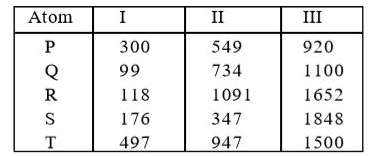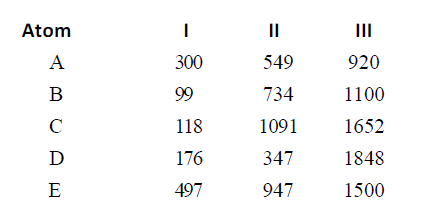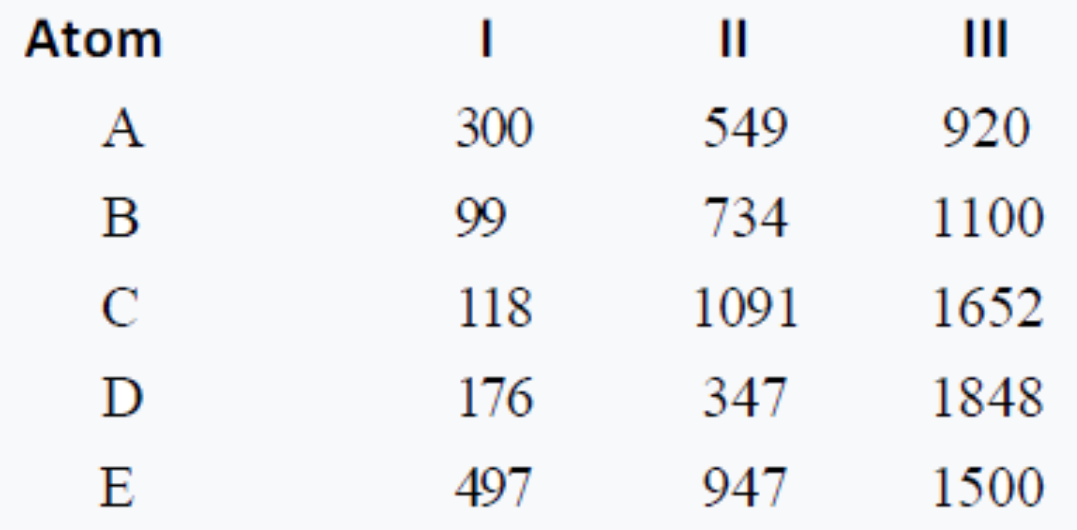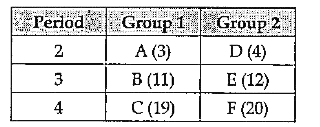Identify the three elements A,BandC from the data given below
a. The elements have successive atomic numbers
b. A forms a stable anion, Aɵ
c. C forms a stable cation, C⊕
To solve the problem of identifying the three elements A, B, and C based on the given clues, we can follow these steps:
Step 1: Understand the Clue about Successive Atomic Numbers
The first clue states that the elements A, B, and C have successive atomic numbers. This means if A has an atomic number Z, then B will have Z+1, and C will have Z+2.
Step 2: Analyze the Clue about A Forming a Stable Anion
The second clue indicates that element A forms a stable anion (A⁻). Elements that typically form stable anions are found in the halogen group of the periodic table, which includes elements like fluorine (F), chlorine (Cl), bromine (Br), etc. These elements have seven valence electrons and can gain one electron to achieve a stable electron configuration.
Step 3: Analyze the Clue about C Forming a Stable Cation
The third clue states that element C forms a stable cation (C⁺). Stable cations are usually formed by alkali metals, which have one electron in their outermost shell. These include lithium (Li), sodium (Na), potassium (K), etc. When these elements lose one electron, they form positive ions.
Step 4: Identify Possible Elements for A
Since A must be a halogen, we can consider two possibilities:
1. If A is chlorine (Cl, atomic number 17), then:
- B would be argon (Ar, atomic number 18)
- C would be potassium (K, atomic number 19)
2. If A is fluorine (F, atomic number 9), then:
- B would be neon (Ne, atomic number 10)
- C would be sodium (Na, atomic number 11)
Step 5: Verify the Conditions
- For the first case (Cl, Ar, K):
- A (Cl) forms a stable anion (Cl⁻).
- C (K) forms a stable cation (K⁺).
- For the second case (F, Ne, Na):
- A (F) forms a stable anion (F⁻).
- C (Na) forms a stable cation (Na⁺).
Both sets of elements satisfy the conditions given in the problem.
Conclusion
The three elements can be identified as:
1. A = Chlorine (Cl) or Fluorine (F)
2. B = Argon (Ar) or Neon (Ne)
3. C = Potassium (K) or Sodium (Na)
The first clue states that the elements A, B, and C have successive atomic numbers. This means if A has an atomic number Z, then B will have Z+1, and C will have Z+2.
The second clue indicates that element A forms a stable anion (A⁻). Elements that typically form stable anions are found in the halogen group of the periodic table, which includes elements like fluorine (F), chlorine (Cl), bromine (Br), etc. These elements have seven valence electrons and can gain one electron to achieve a stable electron configuration.
The third clue states that element C forms a stable cation (C⁺). Stable cations are usually formed by alkali metals, which have one electron in their outermost shell. These include lithium (Li), sodium (Na), potassium (K), etc. When these elements lose one electron, they form positive ions.
Since A must be a halogen, we can consider two possibilities:
1. If A is chlorine (Cl, atomic number 17), then:
- B would be argon (Ar, atomic number 18)
- C would be potassium (K, atomic number 19)
2. If A is fluorine (F, atomic number 9), then:
- B would be neon (Ne, atomic number 10)
- C would be sodium (Na, atomic number 11)
- For the first case (Cl, Ar, K):
- A (Cl) forms a stable anion (Cl⁻).
- C (K) forms a stable cation (K⁺).
- For the second case (F, Ne, Na):
- A (F) forms a stable anion (F⁻).
- C (Na) forms a stable cation (Na⁺).
The three elements can be identified as:
1. A = Chlorine (Cl) or Fluorine (F)
2. B = Argon (Ar) or Neon (Ne)
3. C = Potassium (K) or Sodium (Na)
Topper's Solved these Questions
- PERIODIC CLASSIFICATION OF ELEMENTS AND GENERAL INORGANIC CHEMISTRYBOOK - CENGAGE CHEMISTRY ENGLISHCHAPTER - PERIODIC CLASSIFICATION OF ELEMENTS AND GENERAL INORGANIC CHEMISTRYEXERCISE - Ex 1.1
14 Videos
- PERIODIC CLASSIFICATION OF ELEMENTS AND GENERAL INORGANIC CHEMISTRYBOOK - CENGAGE CHEMISTRY ENGLISHCHAPTER - PERIODIC CLASSIFICATION OF ELEMENTS AND GENERAL INORGANIC CHEMISTRYEXERCISE - Ex 1.1 (Very Short)
22 Videos
- PERIODIC CLASSIFICATION OF ELEMENTS AND GENERAL INORGANIC CHEMISTRYBOOK - CENGAGE CHEMISTRY ENGLISHCHAPTER - PERIODIC CLASSIFICATION OF ELEMENTS AND GENERAL INORGANIC CHEMISTRYEXERCISE - Exercises (Archives )Subjective
4 Videos
- P-BLOCK GROUP 14 - CARBON FAMILYBOOK - CENGAGE CHEMISTRY ENGLISHCHAPTER - P-BLOCK GROUP 14 - CARBON FAMILYEXERCISE - Exercises Archives (Subjective)
9 Videos
- PURIFICATION OF ORGANIC COMPOUNDS AND QUALITATIVE AND QUANTITATIVE ANALYSISBOOK - CENGAGE CHEMISTRY ENGLISHCHAPTER - PURIFICATION OF ORGANIC COMPOUNDS AND QUALITATIVE AND QUANTITATIVE ANALYSISEXERCISE - Assertion Reasoning Type
5 Videos
Similar Questions
Ionization energies of five elements in kcal/mol are given below :

The element form stable unipositive ion?
View SolutionIonization energies of five elements in kcal/mol are given below:

Q. Which element form stable unipositve ion?
View SolutionIonization energies of five elements in kcal/mol are given below:

Q. Which element form stable unipositve ion?
View SolutionIonization energies of five elements in kcal/mol are given below:
 .
.
The element having most stable oxidation state +2 is ?
View SolutionIonization energies of five elements in kcal/mol are given below:
 .
.
Which element forms stable unipositive ion ?
View SolutionIonization energies of five elements in kcal/mol are given below:

Q. The element having most stable oxidation state +2 is?
View SolutionIonization energies of five elements in kcal/mol are given below:

Q. The element having most stable oxidation state +2 is?
View SolutionIn the table given below, six elements are shown with their atomic numbers given in parenthesis.

Among elements A, B, C, which one has largest atomic size.
View SolutionIn the table given below, six elements are shown with their atomic numbers given in parenthesis.

What is electronic configuration of element C.
View SolutionA compound contains three elements A,B and C, if the oxidation number of A=+2B=+5 and C=−2 then possible formula of the compound is
View Solution
